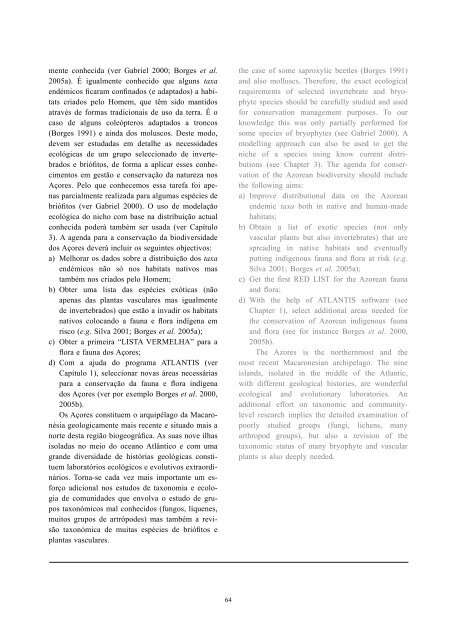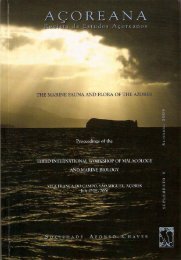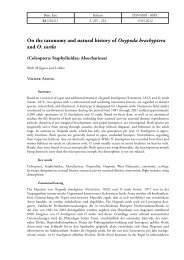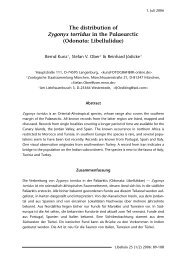(eds.) (2005). - Portal da Biodiversidade dos Açores - Universidade ...
(eds.) (2005). - Portal da Biodiversidade dos Açores - Universidade ...
(eds.) (2005). - Portal da Biodiversidade dos Açores - Universidade ...
You also want an ePaper? Increase the reach of your titles
YUMPU automatically turns print PDFs into web optimized ePapers that Google loves.
mente conheci<strong>da</strong> (ver Gabriel 2000; Borges et al.<br />
<strong>2005</strong>a). É igualmente conhecido que alguns taxa<br />
endémicos ficaram confina<strong>dos</strong> (e a<strong>da</strong>pta<strong>dos</strong>) a habitats<br />
cria<strong>dos</strong> pelo Homem, que têm sido manti<strong>dos</strong><br />
através de formas tradicionais de uso <strong>da</strong> terra. É o<br />
caso de alguns coleópteros a<strong>da</strong>pta<strong>dos</strong> a troncos<br />
(Borges 1991) e ain<strong>da</strong> <strong>dos</strong> moluscos. Deste modo,<br />
devem ser estu<strong>da</strong><strong>da</strong>s em detalhe as necessi<strong>da</strong>des<br />
ecológicas de um grupo seleccionado de invertebra<strong>dos</strong><br />
e briófitos, de forma a aplicar esses conhecimentos<br />
em gestão e conservação <strong>da</strong> natureza nos<br />
<strong>Açores</strong>. Pelo que conhecemos essa tarefa foi apenas<br />
parcialmente realiza<strong>da</strong> para algumas espécies de<br />
briófitos (ver Gabriel 2000). O uso de modelação<br />
ecológica do nicho com base na distribuição actual<br />
conheci<strong>da</strong> poderá também ser usa<strong>da</strong> (ver Capítulo<br />
3). A agen<strong>da</strong> para a conservação <strong>da</strong> biodiversi<strong>da</strong>de<br />
<strong>dos</strong> <strong>Açores</strong> deverá incluir os seguintes objectivos:<br />
a) Melhorar os <strong>da</strong><strong>dos</strong> sobre a distribuição <strong>dos</strong> taxa<br />
endémicos não só nos habitats nativos mas<br />
também nos cria<strong>dos</strong> pelo Homem;<br />
b) Obter uma lista <strong>da</strong>s espécies exóticas (não<br />
apenas <strong>da</strong>s plantas vasculares mas igualmente<br />
de invertebra<strong>dos</strong>) que estão a invadir os habitats<br />
nativos colocando a fauna e flora indígena em<br />
risco (e.g. Silva 2001; Borges et al. <strong>2005</strong>a);<br />
c) Obter a primeira “LISTA VERMELHA” para a<br />
flora e fauna <strong>dos</strong> <strong>Açores</strong>;<br />
d) Com a aju<strong>da</strong> do programa ATLANTIS (ver<br />
Capítulo 1), seleccionar novas áreas necessárias<br />
para a conservação <strong>da</strong> fauna e flora indígena<br />
<strong>dos</strong> <strong>Açores</strong> (ver por exemplo Borges et al. 2000,<br />
<strong>2005</strong>b).<br />
Os <strong>Açores</strong> constituem o arquipélago <strong>da</strong> Macaronésia<br />
geologicamente mais recente e situado mais a<br />
norte desta região biogeográfica. As suas nove ilhas<br />
isola<strong>da</strong>s no meio do oceano Atlântico e com uma<br />
grande diversi<strong>da</strong>de de histórias geológicas constituem<br />
laboratórios ecológicos e evolutivos extraordinários.<br />
Torna-se ca<strong>da</strong> vez mais importante um esforço<br />
adicional nos estu<strong>dos</strong> de taxonomia e ecologia<br />
de comuni<strong>da</strong>des que envolva o estudo de grupos<br />
taxonómicos mal conheci<strong>dos</strong> (fungos, líquenes,<br />
muitos grupos de artrópodes) mas também a revisão<br />
taxonómica de muitas espécies de briófitos e<br />
plantas vasculares.<br />
64<br />
the case of some saproxylic beetles (Borges 1991)<br />
and also molluscs. Therefore, the exact ecological<br />
requirements of selected invertebrate and bryophyte<br />
species should be carefully studied and used<br />
for conservation management purposes. To our<br />
knowledge this was only partially performed for<br />
some species of bryophytes (see Gabriel 2000). A<br />
modelling approach can also be used to get the<br />
niche of a species using know current distributions<br />
(see Chapter 3). The agen<strong>da</strong> for conservation<br />
of the Azorean biodiversity should include<br />
the following aims:<br />
a) Improve distributional <strong>da</strong>ta on the Azorean<br />
endemic taxa both in native and human-made<br />
habitats;<br />
b) Obtain a list of exotic species (not only<br />
vascular plants but also invertebrates) that are<br />
spreading in native habitats and eventually<br />
putting indigenous fauna and flora at risk (e.g.<br />
Silva 2001; Borges et al. <strong>2005</strong>a);<br />
c) Get the first RED LIST for the Azorean fauna<br />
and flora;<br />
d) With the help of ATLANTIS software (see<br />
Chapter 1), select additional areas needed for<br />
the conservation of Azorean indigenous fauna<br />
and flora (see for instance Borges et al. 2000,<br />
<strong>2005</strong>b).<br />
The Azores is the northernmost and the<br />
most recent Macaronesian archipelago. The nine<br />
islands, isolated in the middle of the Atlantic,<br />
with different geological histories, are wonderful<br />
ecological and evolutionary laboratories. An<br />
additional effort on taxonomic and communitylevel<br />
research implies the detailed examination of<br />
poorly studied groups (fungi, lichens, many<br />
arthropod groups), but also a revision of the<br />
taxonomic status of many bryophyte and vascular<br />
plants is also deeply needed.

















